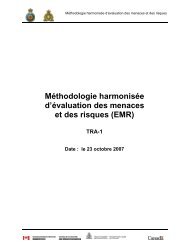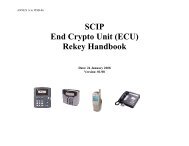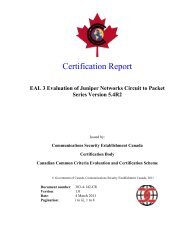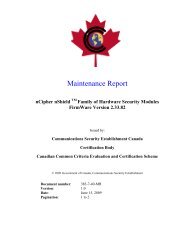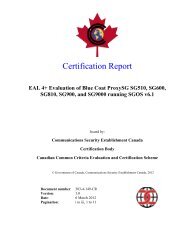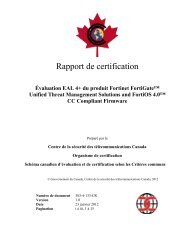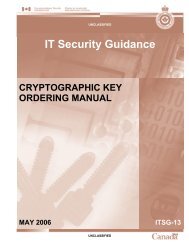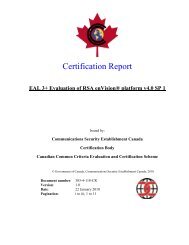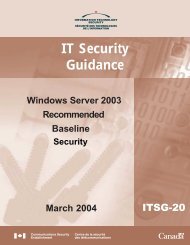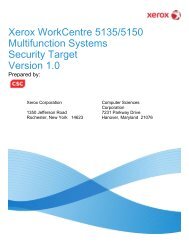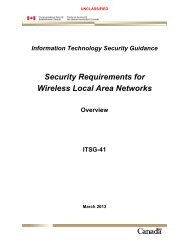Evaluation of Certificate Issuing and Management Components ...
Evaluation of Certificate Issuing and Management Components ...
Evaluation of Certificate Issuing and Management Components ...
Create successful ePaper yourself
Turn your PDF publications into a flip-book with our unique Google optimized e-Paper software.
Certification Report<br />
<strong>Evaluation</strong> <strong>of</strong> <strong>Certificate</strong> <strong>Issuing</strong> <strong>and</strong> <strong>Management</strong><br />
<strong>Components</strong> Protection Pr<strong>of</strong>ile<br />
Version 1.5<br />
Issued by:<br />
Communications Security Establishment Canada<br />
Certification Body<br />
Canadian Common Criteria <strong>Evaluation</strong> <strong>and</strong> Certification Scheme<br />
© Government <strong>of</strong> Canada, Communications Security Establishment Canada, 2011<br />
Document number: 383-6-3-CR<br />
Version: 1.1<br />
Date: 9 September 2011<br />
Pagination: i to iii, 1 to 6
CCS Certification Report CIMC PP v1.5<br />
DISCLAIMER<br />
The Protection Pr<strong>of</strong>ile (PP) identified in this certification report, <strong>and</strong> its associated<br />
certificate, has been evaluated at an approved evaluation facility – established under the<br />
Canadian Common Criteria <strong>Evaluation</strong> <strong>and</strong> Certification Scheme (CCS) – using the Common<br />
Methodology for Information Technology Security <strong>Evaluation</strong>, Version 3.1 Revision 3, for<br />
conformance to the Common Criteria for Information Technology Security <strong>Evaluation</strong>,<br />
Version 3.1 Revision 3. This certification report, <strong>and</strong> its associated certificate, apply only to<br />
the identified version <strong>and</strong> release <strong>of</strong> the protection pr<strong>of</strong>ile listed in this certificate <strong>and</strong> in<br />
conjunction with the complete certification report. The evaluation has been conducted in<br />
accordance with the provisions <strong>of</strong> the CCS, <strong>and</strong> the conclusions <strong>of</strong> the evaluation facility in<br />
the evaluation report are consistent with the evidence adduced. This report, <strong>and</strong> its associated<br />
certificate, are not an endorsement <strong>of</strong> the Protection Pr<strong>of</strong>ile by the Communications Security<br />
Establishment Canada, or any other organization that recognizes or gives effect to this report,<br />
<strong>and</strong> its associated certificate, <strong>and</strong> no warranty <strong>of</strong> the pr<strong>of</strong>ile by the Communications Security<br />
Establishment Canada, or any other organization that recognizes or gives effect to this report,<br />
<strong>and</strong> its associated certificate, is either expressed or implied.<br />
___________________________________________________________________________<br />
Version 1.1 9 September 2011<br />
- Page i <strong>of</strong> iii -
CCS Certification Report CIMC PP v1.5<br />
FOREWORD<br />
The Canadian Common Criteria <strong>Evaluation</strong> <strong>and</strong> Certification Scheme (CCS) provides a<br />
third-party evaluation service for determining the trustworthiness <strong>of</strong> Information Technology<br />
(IT) security products. <strong>Evaluation</strong>s are performed by a commercial Common Criteria<br />
<strong>Evaluation</strong> Facility (CCEF) under the oversight <strong>of</strong> the CCS Certification Body, which is<br />
managed by the Communications Security Establishment Canada.<br />
A CCEF is a commercial facility that has been approved by the CCS Certification Body to<br />
perform Common Criteria evaluations; a significant requirement for such approval is<br />
accreditation to the requirements <strong>of</strong> ISO/IEC 17025:2005, the General Requirements for the<br />
Competence <strong>of</strong> Testing <strong>and</strong> Calibration Laboratories. Accreditation is performed under the<br />
Program for the Accreditation <strong>of</strong> Laboratories - Canada (PALCAN), administered by the<br />
St<strong>and</strong>ards Council <strong>of</strong> Canada.<br />
The CCEF that carried out this evaluation is DOMUS ITSL located in Ottawa, Canada.<br />
By awarding a certificate, a certifying body asserts that a protection pr<strong>of</strong>ile complies with the<br />
requirements for protection pr<strong>of</strong>ile (PP) evaluation specified in the Common Criteria for<br />
Information Security <strong>Evaluation</strong>. A protection pr<strong>of</strong>ile is an implementation-independent set<br />
<strong>of</strong> security requirements for a category <strong>of</strong> IT that meets specific consumer needs. The<br />
objective <strong>of</strong> a protection pr<strong>of</strong>ile evaluation is to ensure that the protection pr<strong>of</strong>ile is complete,<br />
consistent, technically sound <strong>and</strong>, therefore, suitable for use as the basis <strong>of</strong> security<br />
requirements for the relevant category <strong>of</strong> IT.<br />
The protection pr<strong>of</strong>ile associated with this certification report is identified by the following<br />
nomenclature:<br />
Title: <strong>Certificate</strong> <strong>Issuing</strong> <strong>and</strong> <strong>Management</strong> <strong>Components</strong> Protection Pr<strong>of</strong>ile<br />
Version: 1.5<br />
Date: 11 August 2011<br />
Reproduction <strong>of</strong> this report is authorized provided the report is reproduced in its entirety.<br />
___________________________________________________________________________<br />
Version 1.1 9 September 2011<br />
- Page ii <strong>of</strong> iii -
CCS Certification Report CIMC PP v1.5<br />
TABLE OF CONTENTS<br />
Disclaimer ....................................................................................................................................... i<br />
Foreword........................................................................................................................................ ii<br />
Executive Summary...................................................................................................................... 1<br />
1 Identification <strong>of</strong> Target <strong>of</strong> <strong>Evaluation</strong> ................................................................................ 1<br />
1.1 PROTECTION PROFILE ................................................................................................ 1<br />
1.2 PROTECTION PROFILE DEVELOPER ............................................................................ 2<br />
1.3 EVALUATION SPONSOR.............................................................................................. 2<br />
1.4 EVALUATOR............................................................................................................... 2<br />
2 Results <strong>of</strong> the <strong>Evaluation</strong>...................................................................................................... 2<br />
3 <strong>Evaluation</strong> Activities............................................................................................................. 2<br />
4 Common Criteria Conformance.......................................................................................... 3<br />
5 Using the Protection Pr<strong>of</strong>ile ................................................................................................. 4<br />
6 Results <strong>of</strong> the <strong>Evaluation</strong>...................................................................................................... 4<br />
7 Evaluator Comments, Observations <strong>and</strong> Recommendations ........................................... 4<br />
7.1 EXPLICITLY STATED SECURITY REQUIREMENTS ......................................................... 4<br />
7.2 SECURITY OBJECTIVES FOR BOTH THE TOE AND THE ENVIRONMENT ........................ 4<br />
8 Claiming conformance to protection pr<strong>of</strong>iles..................................................................... 4<br />
9 Acronyms, Abbreviations <strong>and</strong> Initializations..................................................................... 5<br />
10 References.............................................................................................................................. 6<br />
___________________________________________________________________________<br />
Version 1.1 9 September 2011<br />
- Page iii <strong>of</strong> iii -
CCS Certification Report CIMC PP v1.5<br />
Executive Summary<br />
<strong>Certificate</strong> <strong>Issuing</strong> <strong>and</strong> <strong>Management</strong> <strong>Components</strong> Protection Pr<strong>of</strong>ile (hereafter referred to as<br />
CIMC PP) is the Protection Pr<strong>of</strong>ile being evaluated.<br />
The <strong>Certificate</strong> <strong>Issuing</strong> <strong>and</strong> <strong>Management</strong> <strong>Components</strong> (CIMC) Protection Pr<strong>of</strong>ile (PP)<br />
defines requirements for components that issue, revoke, <strong>and</strong> manage public key certificates,<br />
such as X.509 public key certificates.<br />
This document was derived from the <strong>Certificate</strong> <strong>Issuing</strong> <strong>and</strong> <strong>Management</strong> <strong>Components</strong><br />
Family <strong>of</strong> Protection Pr<strong>of</strong>iles, Version 1.0, October 31, 2001 (CIMC PP). More specifically,<br />
this PP has essentially adopted the security functional requirements for Security Level 3 in<br />
that PP, while revising the assurance requirements to conform with <strong>Evaluation</strong> Assurance<br />
Level (EAL) 4 augmented with ALC_FLR.2, <strong>and</strong> also to update the content from Common<br />
Criteria (CC) version 2.1 to CC version 3.1 Revision 3.<br />
The original CIMC PP was developed through a collaborative effort between the US<br />
National Institute <strong>of</strong> St<strong>and</strong>ards <strong>and</strong> Technology (NIST) <strong>and</strong> the US National Security Agency<br />
(NSA) with the assistance <strong>and</strong> input <strong>of</strong> vendors.<br />
DOMUS ITSL is the CCEF that conducted the evaluation. The evaluation was performed<br />
using the Common Criteria for Information Technology Security <strong>Evaluation</strong> (CC) [b], <strong>and</strong><br />
the Common Methodology for Information Technology Security <strong>Evaluation</strong> (CEM) [c], <strong>and</strong><br />
was completed on 25 August 2011. It was carried out in accordance with the rules <strong>of</strong> the<br />
Canadian Common Criteria <strong>Evaluation</strong> <strong>and</strong> Certification Scheme (CCS), <strong>and</strong> all evaluation<br />
activities were performed by the CCEF, in accordance with the CEM.<br />
CIMC PP was evaluated against the APE class <strong>of</strong> assurance requirements specified in the<br />
CC. The evaluation has determined that the CIMC PP is a well-written, mature document,<br />
which clearly defines the intended target <strong>of</strong> evaluation (TOE), <strong>and</strong> its intended operating<br />
environment. It meets all <strong>of</strong> the CC requirements specified for protection pr<strong>of</strong>ile evaluation.<br />
Recommendations are provided in this report for those wishing to use or claim conformance<br />
to CIMC PP. Communications Security Establishment Canada, as the CCS Certification<br />
Body, declares that CIMC PP evaluation meets all the conditions <strong>of</strong> the Arrangement on the<br />
Recognition <strong>of</strong> Common Criteria <strong>Certificate</strong>s <strong>and</strong> that the product will be listed on the CCS<br />
Certified Products list (CPL) <strong>and</strong> the Common Criteria portal (the <strong>of</strong>ficial website <strong>of</strong> the<br />
Common Criteria Project).<br />
1 Identification <strong>of</strong> Target <strong>of</strong> <strong>Evaluation</strong><br />
1.1 Protection Pr<strong>of</strong>ile<br />
The evaluated protection pr<strong>of</strong>ile, the subject <strong>of</strong> this certification report, is identified by the<br />
following nomenclature:<br />
___________________________________________________________________________<br />
Version 1.1 9 September 2011<br />
- Page 1 <strong>of</strong> 6 -
CCS Certification Report CIMC PP v1.5<br />
Title: <strong>Certificate</strong> <strong>Issuing</strong> <strong>and</strong> <strong>Management</strong> <strong>Components</strong> Protection Pr<strong>of</strong>ile<br />
Version: 1.5<br />
Date: 11 August 2011<br />
1.2 Protection Pr<strong>of</strong>ile Developer<br />
The original CIMC PP was developed through a collaborative effort between the United<br />
States National Institute <strong>of</strong> St<strong>and</strong>ards <strong>and</strong> Technology (NIST) <strong>and</strong> the United States National<br />
Security Agency (NSA) with the assistance <strong>and</strong> input <strong>of</strong> vendors. If was then modified for<br />
use in Canada by Entrust Limited, through one <strong>of</strong> the original contributing authors.<br />
1.3 <strong>Evaluation</strong> Sponsor<br />
The sponsor <strong>of</strong> the evaluation was Entrust Limited.<br />
1.4 Evaluator<br />
The Common Criteria <strong>Evaluation</strong> Facility (CCEF) that conducted the evaluation is DOMUS<br />
ITSL, located in Ottawa, Canada.<br />
2 Results <strong>of</strong> the <strong>Evaluation</strong><br />
The CIMC PP was successfully evaluated against the requirements <strong>of</strong> the Protection Pr<strong>of</strong>ile<br />
<strong>Evaluation</strong> (APE) class <strong>of</strong> Common Criteria assurance requirements. This means that the PP<br />
is technically sound <strong>and</strong> suitable for use as a statement <strong>of</strong> security requirements for<br />
components that issue, revoke, <strong>and</strong> manage public key certificates, such as X.509 public key<br />
certificates.<br />
The protection pr<strong>of</strong>ile was found to be a well-written, mature document that clearly defines<br />
the intended target <strong>of</strong> evaluation (TOE). It is comprehensive in its description <strong>of</strong> the<br />
environment in which the intended TOE would operate <strong>and</strong> the anticipated threats it would<br />
face.<br />
3 <strong>Evaluation</strong> Activities<br />
The evaluation involved an analysis <strong>of</strong> the CIMC PP against the requirements <strong>of</strong> the APE<br />
class <strong>of</strong> Common Criteria assurance requirements. The objective <strong>of</strong> protection pr<strong>of</strong>ile<br />
evaluation is to determine, by analysis, that the specified security requirements are effective<br />
at solving the security problem defined for the environment in terms <strong>of</strong> threats, policies <strong>and</strong><br />
assumptions. The approach to analysis is pair-wise, whereby the stated security objectives<br />
are verified to be effective against the security problem, <strong>and</strong> the security requirements<br />
verified to satisfy the security objectives. Finally, the security requirements are analyzed to<br />
determine that they are mutually supportive <strong>and</strong> cohesive.<br />
The evaluation <strong>of</strong> the CIMC PP was an iterative process, whereby observations discovered<br />
during evaluation resulted in a revision <strong>of</strong> the CIMC PP <strong>and</strong> its subsequent re-evaluation.<br />
___________________________________________________________________________<br />
Version 1.1 9 September 2011<br />
- Page 2 <strong>of</strong> 6 -
CCS Certification Report CIMC PP v1.5<br />
The evaluation process began in January 2011, with version 1.2 <strong>and</strong> culminated with the<br />
successful evaluation <strong>of</strong> version 1.5 in August 2011. For all versions, all evaluation activities<br />
were performed by the CCEF, in accordance with the Common Methodology for Information<br />
Technology Security <strong>Evaluation</strong> [c].<br />
4 Common Criteria Conformance<br />
The evaluation was conducted using the Common Methodology for Information Technology<br />
Security <strong>Evaluation</strong>, Version 3.1 Revision 3, for conformance to the Common Criteria for<br />
Information Technology Security <strong>Evaluation</strong>, Version 3.1 Revision 3.<br />
CIMC PP is:<br />
a. Common Criteria Part 2 extended, with functional requirements based upon functional<br />
components in Part 2, except for the following explicitly stated requirements defined in<br />
the PP:<br />
FCO_NRO_CIMC.3 Enforced pro<strong>of</strong> <strong>of</strong> origin <strong>and</strong> verification <strong>of</strong> origin;<br />
FCO_NRO_CIMC.4 Advanced verification <strong>of</strong> origin;<br />
FCS_CKM_CIMC.5 CIMC private <strong>and</strong> secret key zeroization;<br />
FCS_SOF_CIMC.1 CIMC Strength <strong>of</strong> Functions;<br />
FDP_CIMC_CER.1 <strong>Certificate</strong> Generation;<br />
FDP_CIMC_CRL.1 <strong>Certificate</strong> Revocation;<br />
FDP_CIMC_CSE.1 <strong>Certificate</strong> status export;<br />
FDP_CIMC_OCSP.1 Basic Response Validation;<br />
FDP_ETC_CIMC.5 Extended user private <strong>and</strong> secret key export;<br />
FDP_SDI_CIMC.3 Stored public key integrity monitoring <strong>and</strong> action;<br />
FMT_MOF_CIMC.3 Extended certificate pr<strong>of</strong>ile management;<br />
FMT_MOF_CIMC.5 Extended certificate revocation list pr<strong>of</strong>ile management;<br />
FMT_MOF_CIMC.6 OCSP Pr<strong>of</strong>ile <strong>Management</strong>;<br />
FMT_MTD_CIMC.4 TSF private key confidentiality protection;<br />
FMT_MTD_CIMC.5 TSF secret key confidentiality protection;<br />
FMT_MTD_CIMC.7 Extended TSF private <strong>and</strong> secret key export; <strong>and</strong><br />
FPT_CIMC_TSP.1 Audit log signing event.<br />
b. Common Criteria Part 3 conformant, with security assurance requirements based only<br />
upon assurance components in Part 3; <strong>and</strong><br />
c. Common Criteria EAL 4 augmented, containing all security assurance requirements in<br />
the EAL 4 package, as well as the following: ALC_FLR.2.<br />
___________________________________________________________________________<br />
Version 1.1 9 September 2011<br />
- Page 3 <strong>of</strong> 6 -
CCS Certification Report CIMC PP v1.5<br />
5 Using the Protection Pr<strong>of</strong>ile<br />
Those claiming conformance or otherwise using the protection pr<strong>of</strong>ile should be aware <strong>of</strong> the<br />
following:<br />
1. The CIMC PP contains a large number <strong>of</strong> security objectives to be met jointly by the<br />
TOE <strong>and</strong> the environment. This is to ensure its applicability to a broad range <strong>of</strong><br />
product types <strong>and</strong> implementations. Users should be aware <strong>of</strong> this <strong>and</strong> refine the ST<br />
to suit the product, technology, <strong>and</strong> organizational implementation type.<br />
2. As permitted by the Common Criteria, there are a large number <strong>of</strong> extended security<br />
functional requirements that typically extend existing functional requirements for the<br />
specific security solution type. All <strong>of</strong> these functional requirements are detailed in<br />
section 6 <strong>of</strong> the CIMC PP [d]. When claiming compliance to the CIMC PP, ST<br />
authors should note these extended security functional requirements <strong>and</strong> determine<br />
that they make sense for the particular TOE conformance.<br />
6 Results <strong>of</strong> the <strong>Evaluation</strong><br />
The overall verdict for the evaluation is PASS. These results are supported by evidence in<br />
the <strong>Evaluation</strong> Technical Report (ETR).<br />
7 Evaluator Comments, Observations <strong>and</strong> Recommendations<br />
7.1 Explicitly stated security requirements<br />
The CIMC PP uses a number <strong>of</strong> explicitly stated security functional requirements. The<br />
reason for using explicitly stated requirements in lieu <strong>and</strong> in refinement <strong>of</strong> the ones provided<br />
by the Common Criteria is due to the nature <strong>of</strong> certificate issuing <strong>and</strong> management<br />
components <strong>of</strong> a PKI.<br />
7.2 Security Objectives for both the TOE <strong>and</strong> the environment<br />
When developing security targets against this PP or using this PP as the basis for selecting a<br />
product, please note that there are a large number <strong>of</strong> security objectives to be met jointly by<br />
the TOE <strong>and</strong> the environment. A needs <strong>and</strong> risk assessment should be performed to<br />
determine specific requirements for the TOE in order to ensure a satisfactory level <strong>of</strong> security<br />
functionality for the TOE as opposed to the environment.<br />
8 Claiming conformance to protection pr<strong>of</strong>iles<br />
One <strong>of</strong> the benefits <strong>of</strong> claiming conformance to an evaluated protection pr<strong>of</strong>ile is the reuse <strong>of</strong><br />
protection pr<strong>of</strong>ile evaluation results for a security target evaluation. The following guidelines<br />
<strong>and</strong> restrictions apply when claiming conformance to a protection pr<strong>of</strong>ile <strong>and</strong> reusing the<br />
protection pr<strong>of</strong>ile evaluation results.<br />
___________________________________________________________________________<br />
Version 1.1 9 September 2011<br />
- Page 4 <strong>of</strong> 6 -
CCS Certification Report CIMC PP v1.5<br />
<br />
<br />
A security target cannot claim conformance to a protection pr<strong>of</strong>ile if it implements<br />
only a subset <strong>of</strong> the security requirements, either functional or assurance, that are<br />
specified in the protection pr<strong>of</strong>ile. A security target may, however, implement a<br />
superset <strong>of</strong> the security requirements specified in a protection pr<strong>of</strong>ile <strong>and</strong> claim<br />
conformance to that protection pr<strong>of</strong>ile. A security target may also claim conformance<br />
to multiple protection pr<strong>of</strong>iles. Security targets that implement a superset <strong>of</strong><br />
protection pr<strong>of</strong>ile security requirements, or that claim conformance to more than one<br />
protection pr<strong>of</strong>ile, must by evaluated to determined that the security requirements<br />
remain mutually supportive.<br />
A protection pr<strong>of</strong>ile to which conformance is claimed may contain uncompleted<br />
security requirement operations. A security target claiming conformance to such a<br />
protection pr<strong>of</strong>ile must complete all operations.<br />
9 Acronyms, Abbreviations <strong>and</strong> Initializations<br />
Acronym/Abbreviation/<br />
Initialization<br />
APE<br />
CC<br />
CCEF<br />
CCRA<br />
CCS<br />
CEM<br />
CIMC<br />
CPL<br />
EAL<br />
ETR<br />
IT<br />
ITSET<br />
NSA<br />
NIST<br />
PALCAN<br />
PP<br />
ST<br />
TOE<br />
Description<br />
Protection Pr<strong>of</strong>ile <strong>Evaluation</strong><br />
Common Criteria<br />
Common Criteria <strong>Evaluation</strong> Facility<br />
Arrangement <strong>of</strong> Recognition <strong>of</strong> Common<br />
Criteria <strong>Certificate</strong>s<br />
Canadian Common Criteria <strong>Evaluation</strong> <strong>and</strong><br />
Certification Scheme<br />
Common Methodology for Information<br />
Technology Security <strong>Evaluation</strong><br />
<strong>Certificate</strong> <strong>Issuing</strong> <strong>and</strong> <strong>Management</strong><br />
Component<br />
Certified Products list<br />
<strong>Evaluation</strong> Assurance Level<br />
<strong>Evaluation</strong> Technical Report<br />
Information Technology<br />
Information Technology Security <strong>Evaluation</strong><br />
<strong>and</strong> Testing<br />
National Security Agency<br />
National Institute <strong>of</strong> St<strong>and</strong>ards <strong>and</strong><br />
Technology<br />
Program for the Accreditation <strong>of</strong> Laboratories<br />
- Canada<br />
Protection Pr<strong>of</strong>ile<br />
Security Target<br />
Target <strong>of</strong> <strong>Evaluation</strong><br />
___________________________________________________________________________<br />
Version 1.1 9 September 2011<br />
- Page 5 <strong>of</strong> 6 -
CCS Certification Report CIMC PP v1.5<br />
10 References<br />
This section lists all documentation used as source material for this report:<br />
a. CCS Publication #4, Technical Oversight, Version 1.8, October 2010.<br />
b. Common Criteria for Information Technology Security <strong>Evaluation</strong>, Version 3.1<br />
Revision 3, July 2009.<br />
c. Common Methodology for Information Technology Security <strong>Evaluation</strong>, CEM,<br />
Version 3.1 Revision 3, July 2009.<br />
d. <strong>Certificate</strong> <strong>Issuing</strong> <strong>and</strong> <strong>Management</strong> <strong>Components</strong> Protection Pr<strong>of</strong>ile, Version 1.5, 11<br />
August 2011<br />
e. <strong>Evaluation</strong> Technical Report <strong>Certificate</strong> <strong>Issuing</strong> <strong>and</strong> <strong>Management</strong> <strong>Components</strong><br />
Protection Pr<strong>of</strong>ile, Version 1.0, 25 August 2011<br />
___________________________________________________________________________<br />
Version 1.1 9 September 2011<br />
- Page 6 <strong>of</strong> 6 -



